BEEF CATTLE
Protocol 1 (4 handlings)
The most common protocol used for beef cattle in Australia. This protocol is based on research and yields the most reliable results.
Features:
-
Requires cattle to be handled 4 times.
-
Reliable protocol – generally yields best results.
Purpose:
-
Synchronising cows/heifers (Bos taurus) for FTAI. Heat detection can also be incorporated into the protocol if desired.
-
Synchronising recipient cows/heifers (Bos taurus) for transfer of either ET or IVF embryos.

Download PDF:
Protocol 2 (3 handlings)
Typically used in commercial FTAI protocols where breeders prefer to limit the number of handlings.
Features:
-
Requires cattle to be handled 3 times.
-
Research shows that this protocol could yield a result up to 5% less than protocol 1. When this protocol is used, it is accepted due to the benefits in reduced handling.
-
Although this protocol works okay in heifers, where possible prefer to use protocol 1.
-
A good choice when:
-
Handling cows and calves to reduce issues with mustering.
-
Holding paddocks are not close to yards or easily mustered.
-
Purpose:
-
Synchronising cows (Bos taurus) for FTAI. Heat detection can also be incorporated into the protocol is desired.
-
When heat detection is used in conjunction with FTAI:
-
Heat detect and AI from evening Day 8 to morning Day 10 using AM/PM rule (no need for GnRH injection in these animals).
-
Day 10, any females that have not been submitted to AI, FTAI as per schedule and administer GnRH.
-
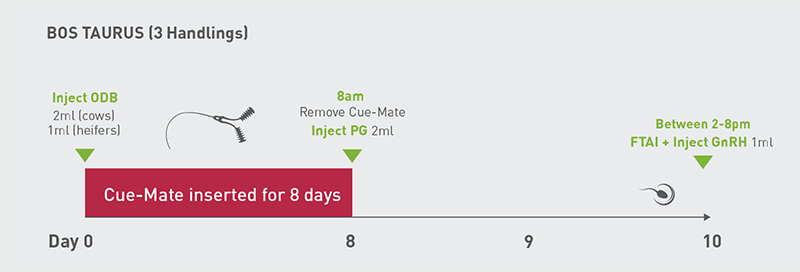
Download PDF:
Protocol 2 (Heifers – Afternoon)
Commonly used protocol for HEIFERS when it is appropriate to AI in the AFTERNOON.
The most common protocol used for Bos indicus heifers. Backed by research and considered to be the ‘best practice’ protocol.
Features:
-
Uses a 1-pod Cue-Mate that has half the standard dose of progesterone (0.78 g). To prepare a 1-pod Cue-Mate replace a progesterone pod with a blank pod.
-
Requires cattle to be handled 4 times.
-
Reliable protocol – generally yields best results.
Purpose:
-
Synchronising heifers for FTAI. Heat detection can also be incorporated into the protocol if desired.
-
Synchronising recipient heifers for transfer of either ET or IVF embryos.

Download PDF:
Protocol 3 (Heifers – Morning)
A new protocol for HEIFERS when it is preferred to AI in the MORNING to avoid the heat or to better organise your day.
Specifically designed for use in Bos indicus heifers. Research has demonstrated that an increase in pregnancy rates may result when using this protocol [7,8].
Features:
-
Uses a 1-pod Cue-Mate that has half the standard dose of progesterone (0.78 g). To prepare a 1-pod Cue-Mate replace a progesterone pod with a blank pod.
-
Heifers are inseminated in the morning out of the heat.
-
Heifers receive a ‘day off’ on Day 8, improving stress associated with multiple handling.
-
Requires cattle to be handled 4 times.
Purpose:
-
Synchronising heifers for FTAI. Heat detection can also be incorporated into the protocol if desired.
-
Synchronising recipient heifers for transfer of either ET or IVF embryos.

Download PDF:
Where possible, we avoid recommending protocols that utilise GnRH in cattle that have Bos indicus content.
Protocol 1 (Cows)
The typical protocol used for COWS with any Bos indicus content.
The most common protocol used for beef cattle in Australia. This protocol is based on research and yields the most reliable results.
Features:
-
Requires cattle to be handled 4 times.
-
Reliable protocol – generally yields best results.
Purpose:
-
Synchronising cows for FTAI. Heat detection can also be incorporated into the protocol if desired.
-
Synchronising recipient cows for transfer of either ET or IVF embryos.
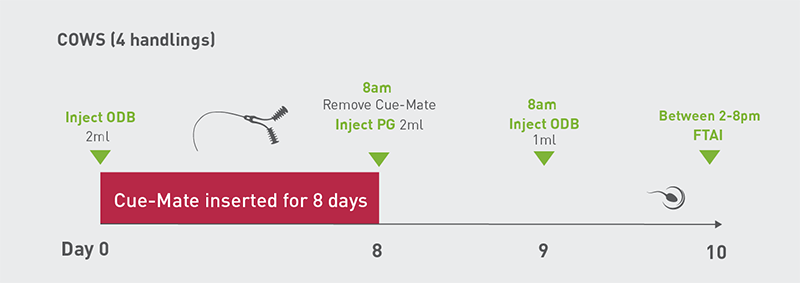
Download PDF:
J-Synch
Features:
- Ideal for beef herds that are not EU accredited.
- This protocol features an extended length between removal of Cue-Mate® device and the time of ovulation, which has been associated with optimal fertility.
- No requirement for heat detection.
Purpose:
- Synchronisation of heifers for FTAI
Synchronisation of recipient heifers for transfer of either ET or IVF embryos
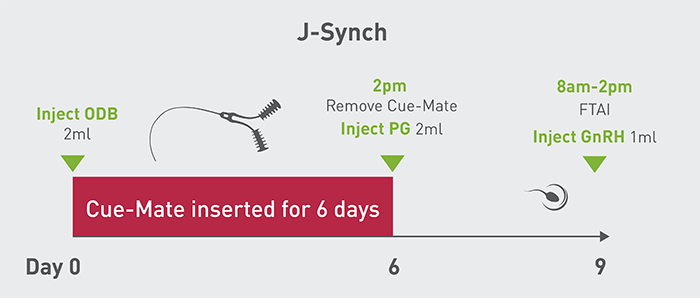
Download PDF: ![]() J-Synch.pdf
J-Synch.pdf
BEEF CATTLE - EU COMPLIANT
Simple FTAI
Protocols for those that wish to take the simple approach to enable FTAI.
Features:
- Morning AI activities for all types of cattle.
- Cows require two injections of PG on Day 5 (at least 8 hrs apart) to ensure full regression of the CL, which is necessary for ovulation to occur.
- Protocols are appropriate for both Bos taurus and Bos indicus cattle.
- No requirement for heat detection.
Purpose:
- Synchronisation of cows/heifers for FTAI
- Synchronisation of recipient cows/heifers for transfer of either ET or IVF embryos
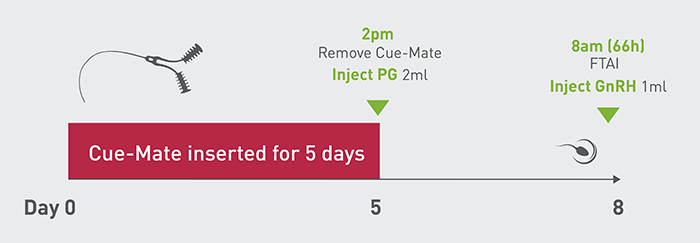
Download PDF: ![]() Beef Protocol_EU_FTAI_Heifers.pdf
Beef Protocol_EU_FTAI_Heifers.pdf
Read the brochure here.
Simple FTAI
Protocols for those that wish to take the simple approach to enable FTAI.
Features:
- Morning AI activities for all types of cattle.
- Cows require two injections of PG on Day 5 (at least 8 hrs apart) to ensure full regression of the CL, which is necessary for ovulation to occur.
- Protocols are appropriate for both Bos taurus and Bos indicus cattle.
- No requirement for heat detection.
Purpose:
- Synchronisation of cows/heifers for FTAI
- Synchronisation of recipient cows/heifers for transfer of either ET or IVF embryos

Download PDF: ![]() Beef Protocol_EU_FTAI_Cows.pdf
Beef Protocol_EU_FTAI_Cows.pdf
Read the brochure here.
FTAI with heat detection
Protocols for those that want to enjoy the benefits of FTAI, but are happy to spend a little more time to get the best result per straw of semen used.
Features:
- Cows require two injections of PG on Day 5 (at least 8 hrs apart) to ensure full regression of the CL, which is necessary for ovulation to occur.
- Protocols are appropriate for both Bos taurus and Bos indicus cattle.
- Heat detection aids (Tail Paint, Estrotect or Kamar) are used to select heifers/cows for first round of FTAI. No need to visually observe heifers/cows in standing heat.
- Option to use sexed, rare, or more expensive semen in heifers/cows that have been identified on heat, by heat detection aids for first round of FTAI. These animals are likely to have a higher pregnancy rate to AI.
Purpose:
- Synchronisation of cows/heifers for FTAI where resources are sufficient to handle the cattle more frequently.
- When breeders are seeking a higher pregnancy rate per straw of semen.

Download PDF: ![]() Beef Protocol_EU_HDandFTAI_Heifers.pdf
Beef Protocol_EU_HDandFTAI_Heifers.pdf
Read the brochure here.
FTAI with heat detection
Protocols for those that want to enjoy the benefits of FTAI, but are happy to spend a little more time to get the best result per straw of semen used.
Features:
- Cows require two injections of PG on Day 5 (at least 8 hrs apart) to ensure full regression of the CL, which is necessary for ovulation to occur.
- Protocols are appropriate for both Bos taurus and Bos indicus cattle.
- Heat detection aids (Tail Paint, Estrotect or Kamar) are used to select heifers/cows for first round of FTAI. No need to visually observe heifers/cows in standing heat.
- Option to use sexed, rare, or more expensive semen in heifers/cows that have been identified on heat, by heat detection aids for first round of FTAI. These animals are likely to have a higher pregnancy rate to AI.
Purpose:
- Synchronisation of cows/heifers for FTAI where resources are sufficient to handle the cattle more frequently.
- When breeders are seeking a higher pregnancy rate per straw of semen.

Download PDF: ![]() Beef Protocol_EU_HDandFTAI_Cows.pdf
Beef Protocol_EU_HDandFTAI_Cows.pdf
Read the brochure here.
You can find the PDF brochure version of the EU protocols here.
DAIRY CATTLE
Protocol 2 – Cue-Mate + Oestradiol (4 handlings)
A commonly used protocol. The use of oestradiol benzoate is permitted in heifers.
Features:
-
Requires cattle to be handled 4 times.
-
Reliable protocol – generally yields best results.
Purpose:
-
Synchronising heifers for FTAI. Heat detection can also be incorporated into the protocol if desired.
-
Synchronising heifers for transfer of either ET or IVF embryos.
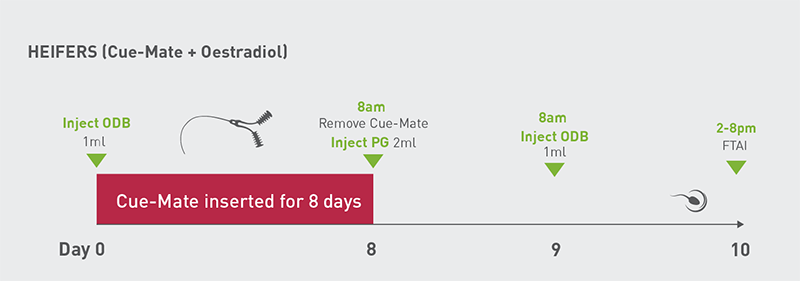
Download PDF:
Protocol 3 – Cue-Mate + Oestradiol (3 handlings)
Typically used where producers prefer to limit the number of handlings.
Features:
-
Requires cattle to be handled 3 times.
-
This protocol could yield a result up to 5% less than protocol 1. When this protocol is used, it is accepted due to the benefits in reduced handling.
Purpose:
-
Synchronising heifers for FTAI. Heat detection can also be incorporated into the protocol is desired.
-
When heat detection is used in conjunction with FTAI:
-
Heat detect and AI from evening Day 8 to morning Day 10 using AM/PM rule (no need for GnRH injection in these animals).
-
Day 10, any females that have not been submitted to AI, FTAI as per schedule and administer GnRH.
-
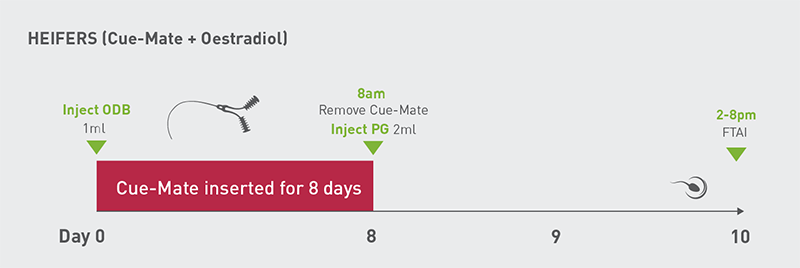
Download PDF:
Protocol 1 – Cue-Mate + OvSynch
The OvSync protocol is a well-known protocol for synchronising cows in dairy herds. However, it can be unreliable producing variable results. When including a Cue-Mate® into an OvSynch protocol there are numerous benefits.
Features:
-
Improves the synchrony of ovulation compared to a basic OvSynch program – more reliable results.
-
Treats NVO cows in advance, getting these cows in calf earlier.
-
Can treat some reproductive disorders.
-
Can be used in heifers.
Purpose:
-
Synchronising cows/heifers for FTAI. Heat detection can also be incorporated into the protocol if desired.
-
Synchronising recipient cows/heifers for transfer of either ET or IVF embryos.
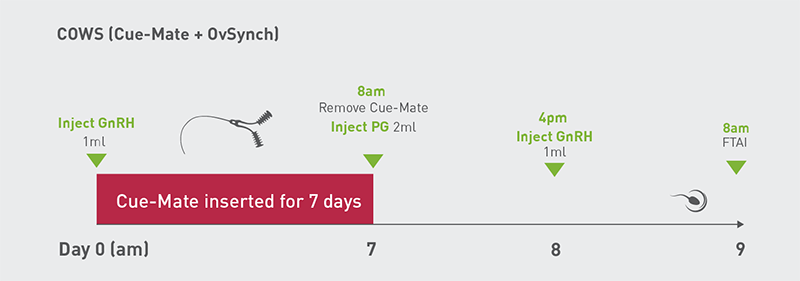
Download PDF:
DONOR COWS
Protocol 4 – Donor Cows
Donor cow protocols will vary considerably. The dose of FSH is tailored according to each female. We strongly recommend that you utilise a protocol that is prescribed by your ET technician.
An example of a typical protocol to superovulate and synchronise a donor cow is listed below. The protocol features the use of a Cue-Mate®, when used in conjunction with oestradiol benzoate has tight control over the follicular wave. This enables a targeted use of the FSH to ensure that an optimal superovulatory response.
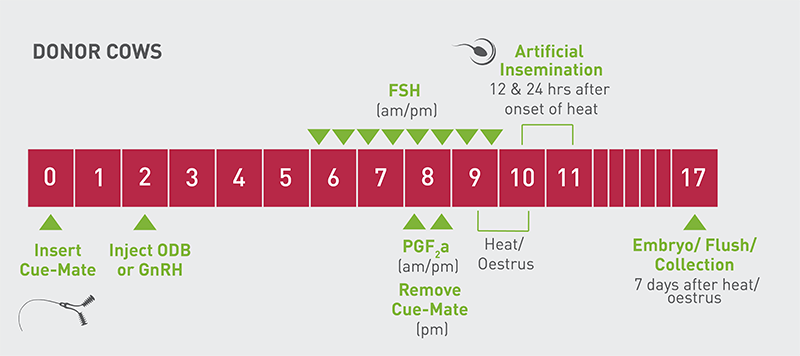
Download PDF: ![]() Donor cows_superovulation.pdf
Donor cows_superovulation.pdf
SHEEP
Protocol 2 – Donor Ewes
Donor ewe protocols may vary considerably. We strongly recommend that you utilise a protocol that is prescribed by your ET technician.
An example of a typical protocol to superovulate and synchronise a donor ewe is listed below.

Download PDF:
KEY: ODB: oestradiol benzoate (1 mg/ml) PG: Prostaglandin (cloprostenol; 250 μg/ml) GnRH: Gonadotrophin releasing hormone (Gonadorellin; 100 μg/ml) Pregnecol: Equine chorionic gonadotrophin (200 IU/ml) Cue-Mate®: Intravaginal progesterone device (1.56 g progesterone) 1-pod Cue-Mate®: (0.78 g progesterone).
SEX-SORTED SEMEN PROTOCOLS
J-Synch with sex-sorted semen
Heifers - beef & dairy
Click on the PDF to view the interactive protocol
Download PDF: ![]() J-Synch protocol interactive_v2.pdf
J-Synch protocol interactive_v2.pdf
